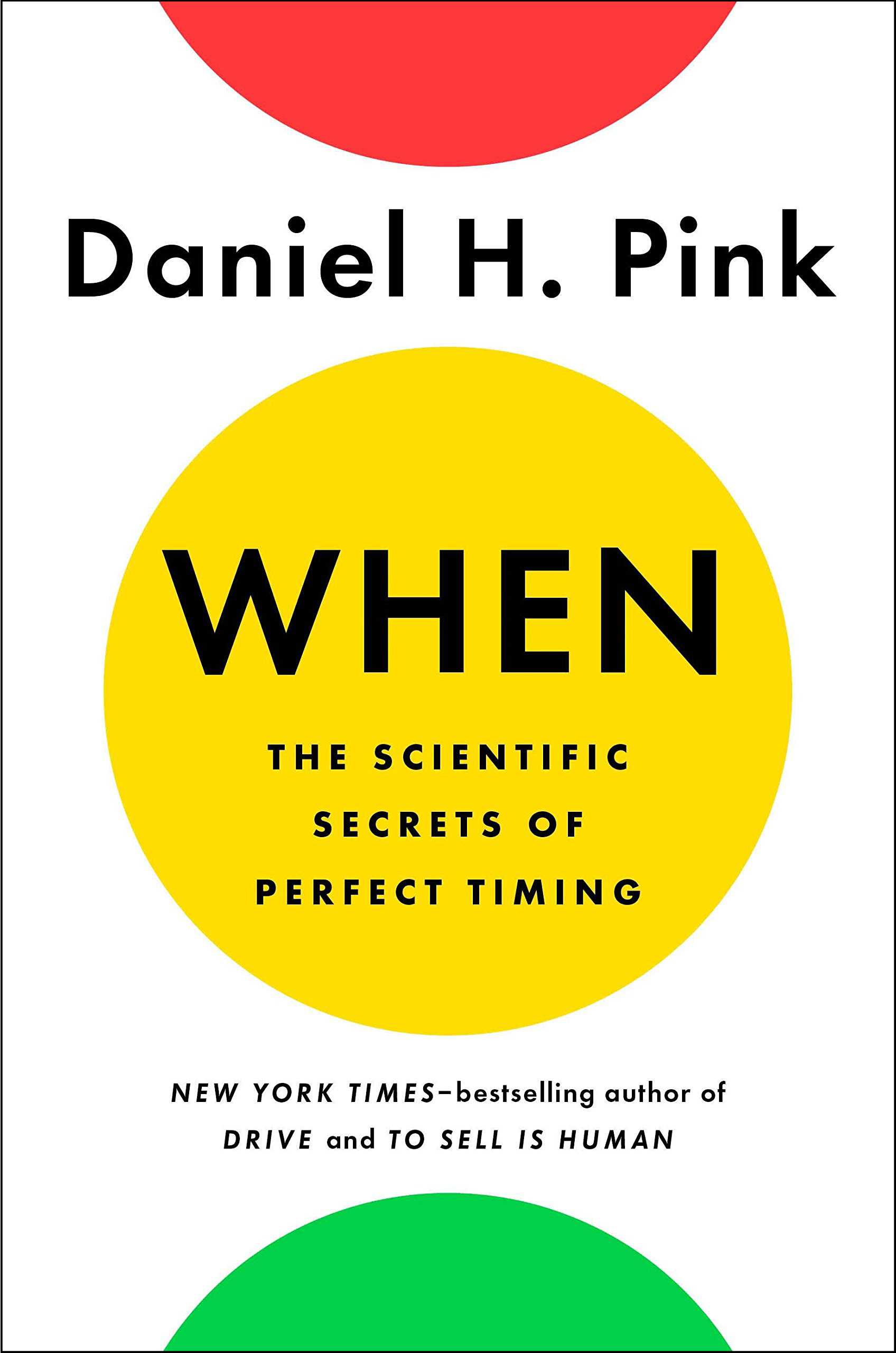INSIDER: When—The Scientific Secrets of Perfect Timing
Clint Ratliff, MBA Candidate
 Opportunity comes when it’s good and ready. As business professionals, it is our job to seek out opportunity and prepare to take advantage of it. But much like lyrics to the infamous Dr. John song, how often do we find ourselves saying, “I been in the right place, but it must have been the wrong time”?
Opportunity comes when it’s good and ready. As business professionals, it is our job to seek out opportunity and prepare to take advantage of it. But much like lyrics to the infamous Dr. John song, how often do we find ourselves saying, “I been in the right place, but it must have been the wrong time”?
In his book, When—The Scientific Secrets of Perfect Timing, Daniel H. Pink reaffirms the idea that “timing is everything” and provides practical applications to incorporate in our daily lives. Through anecdotal discourse and scientific research, Pink imparts a better understanding of what time means to us, why each component of time is important, and how we can get the most out of each part and ourselves.
THINK POINT #1: Understanding the Day
Ruled by the sun, human existence has adhered to the morning, afternoon, and evening cycle throughout history. We rise and fall with the innate idea that the earth’s rotation governs our days. Contrary to this notion, Pinks submits that the day is comprised of a less tangible cycle that greatly impacts the way that business professionals perform. Guiding our thoughts, actions, and energy levels is a cycle the author describes as the peak, the trough, and the rebound.
The peak is the portion of each day where a person experiences their optimal emotional point. The mind works almost flawlessly, allowing us to reach our greatest potential for task execution. The peak is followed by the trough, a time of mental fatigue or despair that renders us incapable of superlative performance. This experience encourages our bodies to enter the rebound stage in order to recover and prepare for the next cycle. Through sociological research, Pink found that this daily cycle held up across all individuals, regardless of age, sex, ethnicity, etc. From viewing the description of each stage, you may be well aware of its existence in your own life. But what exactly does it mean to you? And how are you able to utilize this knowledge in order to perform better in the field of real estate?
To answer this question, you must first know your bird type. Are you a lark, an owl, or a third bird? Sounds funny, right? Pink’s book provides these avian categories to define the way each type of person experiences his or her daily cycle. Each bird represents the biological rhythms of a person’s sleep cycle on “free days,” or days where responsibilities are limited and we have the capability to wake up whenever we’d like. Larks are the early birds, rising promptly and feeling energized during the day but wearing out by evening. Third birds follow suit with a slightly later start time. Each of these categories follow the peak, trough, and rebound cycle detailed above. Owls, however, have a flipped schedule, feeling energized in the evening, rebounding, and starting the day with the trough. Whatever bird you may be, as Pink says, “figure out your type, understand your task and then select the appropriate time.” Following the cues of your daily cycle will allow you to be more productive, getting the most out of yourself and your day. Organize more thought-intensive work during your peak, save simple tasks for your trough, and thoughtlessly trudge through the more monotonous tasks during recovery.
THINK POINT #2: Beginnings, Midpoints & Endings
Following the cycle of your day (and learning how to get the most out of it) is paramount to finding success as a business professional. Taking this idea further, understanding the cycle of life helps us better understand the roles we must play in each part. The second section of Pink’s book provides an in-depth analysis of beginnings, midpoints, and endings.
To master beginnings, we must understand how to start right, start again, and start together. Starting right revolves around understanding your daily cycle and planning your day accordingly. The real estate industry can be demanding. When time permits, allow yourself to start at a more reasonable hour to improve cognitive function and retention. When this isn’t an option and business becomes overbearing, provide yourself with an opportunity to start again. Be willing to pivot in order to reassess your starting point and adjust accordingly. Starting together allows us to form bonds with our coworkers, enabling us to share in burdens and joy. At the start of any project, anticipate problems you may encounter and develop initiatives to avoid them before the project begins. As Pink puts it, “although we can’t always determine when we start, we can exert some influence on beginnings—and considerable influence on the consequences of less than ideal ones.”
In every event (project, relationship, lifespan, etc.), there exists a midpoint that either numbs our interests and stalls our progress or awakens our motivation and propels us forward. Pink refers to these effects as the slump and the spark. The key with midpoints is to understand which effect you’re experiencing and make adjustments to improve your overall well-being. As many approach middle age, the recognition of unremarkable accomplishments or unfulfilled expectations creeps in. While studies show this feeling can primarily be attributed to our biology, the same feeling exists in a sociological context for projects. We hit the middle, we realize we haven’t progressed as far as we’d hoped, and a feeling of despair settles in. When you reach this point, whether it be in a project or the trajectory of your career, Pink encourages you to rely on the uh-oh effect. When you notice you’re halfway through the time you’ve been allotted, let stress kick in to revive your motivation and reshape your strategy. Recognizing that you’re running slightly behind can provide the inspirational wake-up call needed to push through and achieve your goals.
Like beginnings and midpoints, endings are the subtle hand guiding our thoughts and actions. Pink asserts that endings shape our behavior in four predictable ways—they help us energize, encode, edit, and elevate. The energizing portion is simple; seeing the end provides the boost needed for completion. In the beginning, we’re generally more motivated by what we’ve accomplished thus far, but near the end, we’re energized by finishing the little we have left. Encoding utilizes endings to help determine the outlook we take for the entirety of the process. Endings help us edit out the portions that aren’t worth remembering while highlighting the good portions that elevate our worth. Meaningful endings, however, are fairly complex. A mixture of happiness and sadness in an ending is what helps us, as humans, comprehend our experiences. As Pink says, “powerful endings deliver poignancy because poignancy delivers significance.” When facing the finish of a sale or project, allow the ending to reinvigorate your determination and conclude with confidence.
THINK POINT #3: Synching & Thinking
The Dabbawalas of Mumbai are a group of roughly 5,000 individuals who deliver over 200,000 lunches across Mumbai each day. Utilizing a vast network of bicycles and public transit, the Dabbawalas traverse the busy streets of Mumbai day-in and day-out delivering home-cooked meals from family residences to city-wide businesses. This elite group is always on time despite employing no technology in their delivery system. How does such a large group operate so efficiently and effectively in the overpopulated commercial capital of India? The key to the Dabbawalas’ success is synchronization.
 To achieve this level of synchronization, Pink contends that a group must synchronize on three levels: to the boss, to the tribe, and to the heart. The key to group timing is simple—a group must have a boss to help set the pace, maintain standards, and focus the collective mind of the group. A boss, literal or metaphorical, provides the guidance needed for a group to work well together. But successfully working together goes far beyond leadership. Successful groups are synched to the tribe—a sense of belonging exists among them that makes the whole feel greater than its parts. Pink believes the tribe synch for the Dabbawalas is derived from a heightened sense of coordination across codes, garb, and touch. A shared culture/language along with markers of affiliation help foster a sense of belonging for the group. As this sense of belonging grows, the group synchs to the heart through shared purpose.
To achieve this level of synchronization, Pink contends that a group must synchronize on three levels: to the boss, to the tribe, and to the heart. The key to group timing is simple—a group must have a boss to help set the pace, maintain standards, and focus the collective mind of the group. A boss, literal or metaphorical, provides the guidance needed for a group to work well together. But successfully working together goes far beyond leadership. Successful groups are synched to the tribe—a sense of belonging exists among them that makes the whole feel greater than its parts. Pink believes the tribe synch for the Dabbawalas is derived from a heightened sense of coordination across codes, garb, and touch. A shared culture/language along with markers of affiliation help foster a sense of belonging for the group. As this sense of belonging grows, the group synchs to the heart through shared purpose.
When building your real estate business, consider implementing policies that will help foster the same level of commitment to purpose and relationships witnessed between the Dabbawalas. As a leader, give perspective and direction to agents while maintaining common ground with them. Create a welcoming atmosphere within the agency that encourages comradery amongst your agents—the goal is to help build the team vibe for your sellers. Promote a mission with passion, and motivate others to join in. When all three levels are in synch and relational connectivity is at its pinnacle, all pursuits become attainable.
Conclusion
Taking advantage of opportunity almost always comes down to one thing—timing. Through understanding our days, the cycle of life, and the synchronization of our organizations, we are better equipped to find success in our business endeavors. In When—The Scientific Secrets of Perfect Timing, Pink provides a “Time Hacker’s Handbook” section at the end of each chapter to provide quick tips for improving your when. Whether you’re looking to increase efficiency in your personal life or help get the most out of your business, Pink’s book provides the insight you need to get there.
. . . . . . . . . . . . . . . . . . .
Recommended Reading
Pink, Daniel H. (2018), When—The Scientific Secrets of Perfect Timing, New York, NY: Riverhead Books.
. . . . . . . . . . . . . . . . . . .
Reference
Rebennack, Malcolm “Dr. John” (1973), “Right Place, Wrong Time,” In the Right Place, Louisiana Music Factory.
. . . . . . . . . . . . . . . . . . .
About the Author
Clint Ratliff, MBA Candidate
Baylor University
Clint Ratliff is a graduate student from Durango, Texas. After spending the last six years in Los Angeles working in Music and Film, Clint is now pursuing an MBA with a concentration in Data Analytics. He earned his Bachelor's degree in Marketing from Baylor University. Clint plans to work in advertising post grad school, finding innovative ways to seamlessly integrate data into the creative.